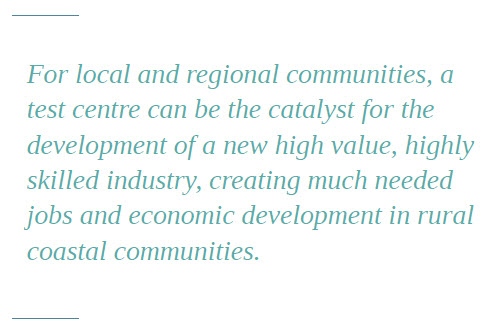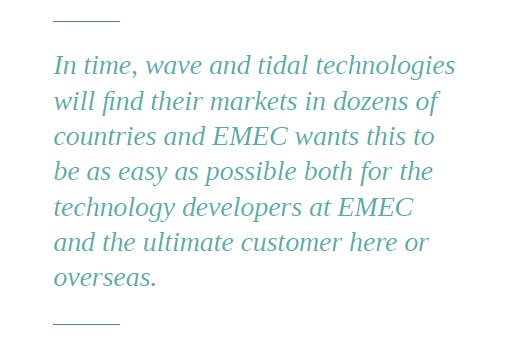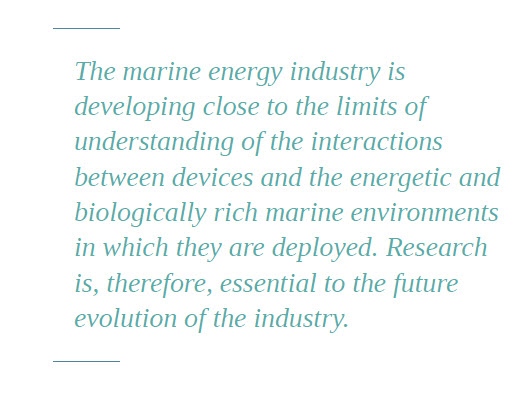Interview with EMEC - UK
|
|
OLIVER WRAGG COMMERCIAL DIRECTOR EMEC |
 What was the motivation and the driving forces to build The European Marine Energy Centre (EMEC) Ltd, and what milestones were set up for its development? To date, how much funding (public and private) has been granted for its creation and operation?
What was the motivation and the driving forces to build The European Marine Energy Centre (EMEC) Ltd, and what milestones were set up for its development? To date, how much funding (public and private) has been granted for its creation and operation?
|
Established in 2003, The European Marine Energy Centre (EMEC) Ltd is the first and only centre of its kind in the world to provide developers of both wave and tidal energy converters with purpose-built, accredited open-sea testing facilities. EMEC was established to simultaneously accelerate the development of wave and tidal energy technology, whilst also stimulating economic development in coastal communities. In 2001, the UK House of Commons Science and Technology Committee recommended that the Orkney Islands in Scotland would be ideal for becoming the home for the European Marine Energy Centre, due to strong wave and tidal resources, combined with energy, environmental and maritime skills in the local community. The wave site at Billia Croo opened in 2004, hosting the Pelamis P1 which became the world’s first floating wave energy device to generate electricity to the national grid. In 2006, the tidal test site at Fall of Warness opened, which just two years later saw client OpenHydro become the first tidal turbine to generate electricity to the grid in the UK. 13 years later EMEC has now hosted 17 wave and tidal energy clients (with 27 marine energy devices) spaning 9 countries. |
 |
To date EMEC has received in the region of £36 million of public investment from a combination of local, regional, national, and European sources. These include Orkney Islands Council, Highlands and Islands Enterprise, Scottish Government, UK Government, European Regional Development Funding, and the European Commission. Since 2011 EMEC has sustained financial independence.
 It is recognised that test centres can be instrumental in proving the technology can work in challenging marine environments. What other benefits do you see for developers and also for local/regional communities?
It is recognised that test centres can be instrumental in proving the technology can work in challenging marine environments. What other benefits do you see for developers and also for local/regional communities?
There are so many benefits it is sometimes hard to know where to start. From a technology developers’ perspective, the major benefit has to be the removal of barriers to deployment, notably consenting, data collection, stakeholder engagement and grid regulation. As EMEC is an independently accredited test laboratory and verification centre, there is also great benefit that technology developers can avail of by securing independent test results and performance verifications of power performance and other key technology claims. These reports can help secure future finance and investment to move technology towards commercialisation. They can also aid certification and help to reduce insurance costs.
EMEC also provides a shop window to the industry. Every year we host more than 300 visitors from around the world. These visitors are a combination of governments, investors, research organisations, utilities and supply chain companies from around the world.
For local and regional communities, a test centre can be the catalyst for the development of a new high value, highly skilled industry, creating much needed jobs and economic development in rural coastal communities. These are particularly important as much of the skills required to support ocean energy are often already present in these communities, e.g. offshore operations knowledge gained by fishermen. Test centres also benefit the local communities as they provide an area where concerned local stakeholders, e.g. fishermen, ferries and other sea users, can view first hand the limited impact that ocean energy has on the environment in which they operate.
To put the economic impact of EMEC into context, since it was created in 2003, EMEC has generated a gross value added to the UK economy of £249.6 million, with 3,801 full-time equivalent (FTE) job years so far, according to an economic impact assessment commissioned by Highlands and Islands Enterprise. This equates to 380 permanent FTE in the UK economy over the course of 10 years, 149 of which have been based in Orkney.
 For ocean energy in general, do you think test centres have a role to play on giving international visibility to the sector? Do you see improvement potential in this respect, and have suggestions?
For ocean energy in general, do you think test centres have a role to play on giving international visibility to the sector? Do you see improvement potential in this respect, and have suggestions?
EMEC has always seen one of its key roles as being a shop window for ocean energy, not just in the UK but globally. At the end of the day, technology cannot be proven unless it is deployed and to coin a phrase from the EMEC Managing Director we need to “get metal wet”. We can all see pictures and images of technology in the water at conferences, events and on websites, but based on the number of visitors EMEC receives each year, it can definitely be concluded that seeing is believing. One area that EMEC is working to improve is how we work collaboratively with our clients and innovation partners, notably at conferences, we are seeing our role more to help SME companies promote their work to wide audiences with real life examples. EMEC has also hosted a European Ocean Energy day in 2014 where we held an open doors event and hosted multiple members of the European Commission. Being able to communicate the real-life challenges and opportunities to key stakeholders is an important role of a test centre. EMEC hopes to be able to replicate the success of the 2014 European Ocean Energy day and believes that it is important that other test centres around the world actively engage with their relevant public stakeholders to demonstrate success in ocean energy.
 There are several test centres around the world, how do you see the possibility of knowledge sharing between these test centres? Apart from technology-specific details that are usually under non-disclosure, what information could be shared to support the sector?
There are several test centres around the world, how do you see the possibility of knowledge sharing between these test centres? Apart from technology-specific details that are usually under non-disclosure, what information could be shared to support the sector?
|
EMEC’s vision is to create a globally successful marine energy industry which undoubtedly requires knowledge sharing and collaboration. To this end EMEC has taken an active lead in trying to improve the coordination between international test centres, notably by the creation of the International Wave and Tidal Energy Research Sites (International WATERS). International WATERS is a collective of developed and developing open ocean test facilities around the world. It has met three times in the past three years and future events are planned. The objective is to share learning between test centres so that lessons can be learnt and collaborations formed. As the world’s first test centre of its kind, EMEC has experienced a huge learning curve and wants to support other test centres by exporting this knowledge, reducing the duplication of work or any mistakes. In terms of priority, EMEC consistently finds that collaboration in the areas of testing and standards is beneficial. One only has to travel overseas and attempt to plug in a computer to experience why this is important. Every country established their own standards for plugs and sockets in isolation and the end result is pointless diversity of detail in the simple plugs throughout the world. |
 |
Marine energy devices are no different. In time, wave and tidal technologies will find their markets in dozens of countries and EMEC wants this to be as easy as possible both for the technology developers at EMEC and the ultimate customer here or overseas. We want a wave or tidal device which is certified at EMEC to be immediately marketable in any country, without expensive and time consuming re-validation.
The establishment of common global standards will be central to this. That is why, for more than a decade, EMEC has been at the very forefront of the development of international standards, having coordinated the development of a suite of 12 industry guidelines, 6 of which are being used as starting points for the first international standards for marine energy and are being developed as technical specifications.
Critical to this, I believe, is the development of a standard approach to performance and resource assessment. If technologies invented in the UK and developed here at EMEC are to become established as global products, then it is vital that each international test centre uses the same common standards so investors can compare results from one centre with results at another. The establishment of a global network of test sites will lead to a community of interest with common standards and approaches to the business of marine energy. Common standards, developed by worldwide experience, can only help accelerate the deployment of wave and tidal technologies.
|
Each country has its own unique conditions, both physical and political, and exploring these challenges simultaneously will enable marine energy technologies to colonise these optimum niches more rapidly than if tackled in isolation. The FORESEA project (Funding Ocean Renewable Energy through Strategic European Action) is another excellent example of how test facilities can work together. The collaboration between EMEC, Smart Bay (Ireland), SEMREV (France), Tidal Testing Centre (Holland) and Ocean Energy Europe (Belgium), is working to provide dedicated support packages to technology developers looking to get kit in the water. Through the FORESEA project we have seen first-hand how test centres can work collaboratively to assist the industry. Another example of collaboration and knowledge sharing is the Marinet project which is now being followed by Marinet2. |
 |
 Would you like to mention any key lessons from your experience over the operation of the test centre? Have expenses kept reasonably within foreseen limits, or were there any major unforeseen challenges?
Would you like to mention any key lessons from your experience over the operation of the test centre? Have expenses kept reasonably within foreseen limits, or were there any major unforeseen challenges?
There have been an incredible number of lessons learned along the path of EMEC’s development – the importance of planning survey data, contracting strategies for design and construction, commissioning and handover of assets.
Cables have been installed using a number of different techniques (vessel mounted carousel, barge and dynamically positioning (DP) vessel). Key to being able to maintain test infrastructure and deliver client’s requirements is operational management. EMEC’s Operations team are involved throughout the client lifecycle supporting the developers through site access, data collection, and electrical systems. For example, installation of devices at the tidal test site at the Fall of Warness is dictated by tidal conditions. The period for installation activities, due to the favourable tidal windows, can be considered by all developers for the installation of their device leading to instances where more than one developer can be working on site at the same time. The marine energy industry is developing close to the limits of understanding of the interactions between devices and the energetic and biologically rich marine environments in which they are deployed. Research is, therefore, essential to the future evolution of the industry.
It is important to EMEC that environmental monitoring undertaken at its test sites is informed and guided by expert input. EMEC is therefore keen to ensure that its environmental monitoring programme should be guided by Regulatory and expert input. It must identify the key environmental sensitivities at the site and aim to assess the potential for wave and tidal energy devices to cause negative effects or impacts on this receiving environment. From an early stage EMEC recognised the need to develop a strong Health & Safety (H&S) management system that met international standards. Similarly, the need for exemplary environmental management was recognised.
As EMEC moved into collection of data and established capability to manipulate and report test and other data, the need for quality assurance (QA) management became more acute. The idea evolved that these management systems had a great deal in common so that there was logic in integrating the management systems - hence the EMEC Integrated Management System (IMS) approach
was adopted.
Working within ocean energy over the past 14 years EMEC has seen many evolutions within the industry. The biggest challenge has been to stay responsive to industry needs – sites, equipment and systems have been reconfigured over time in response to demand. This is a natural consequence of the space we inhabit – on the edge of innovation. Examples of this relate to the length of contracts that we are providing, we are seeing more tidal technology developers seeking opportunities for pre-commercial array demonstration. From the wave energy industry, we are seeing a need to assist technology developers at earlier TRLs, for example the Horizon 2020 WaveBoost project we are working on with CorPower.
In terms of delivering the infrastructure, EMEC has successfully project managed the continuous evolution of the test centre. This has been achieved through careful planning, project management and consciously having one eye on the future to anticipate the needs of the industry. The most valuable learning however, is the domain of the technology companies who are testing their devices – what we can say is that the value of real sea testing is critical to any technology development pathway. Only by proving performance in a real sea environment can developers truly progress to commercial projects. Verified performance data from open-water testing will continue to build confidence amongst the investment community and help developers bring their concepts to a global clean energy market.




